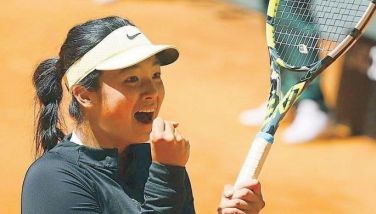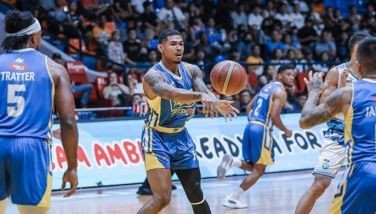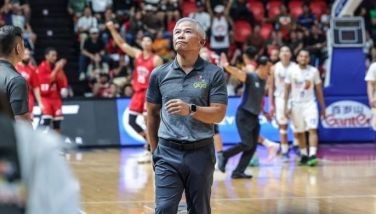Hoshina unfazed by bum knee

LONDON – Hobbled by a left knee injury, Filipino-Japanese hopeful Tomohiko Aldaba Hoshina is up against all odds when he battles two-time World Cup champion Sung Min Kim of Suwon City, South Korea, in the first round of the men’s +100 kilogram judo division at the ExCel North Arena here today.
Hoshina, 25, confessed that he has a torn ligament in the left knee but will do his best in trying to overcome Kim. His Japanese coach Yasuhiro Sato said despite the injury, it’s a 50-50 proposition in the duel to advance.
In the tournament format, judokas face off until the last two survivors clash for the gold medal. There are 32 competitors in Hoshina’s class. The four quarterfinal losers stay alive and meet in two repechage bouts with the winners moving on to confront the defeated semifinalists to decide two bronze medalists. The objective of each bout is to force an opponent to the mat which is called a tatami. Each match can last up to five minutes. Points are awarded for throws and holds. A judoka can score a maximum score, of ippon, by throwing an opponent onto his back, holding him down for at least 25 seconds or gaining submission from an armlock or strangle. An ippon ends the contest in the same way a knockout finishes a boxing bout. Contestants are given “passivity” penalties if they resort to excessive defensive tactics. If the scores are even after five minutes, a playoff or golden score overtime ensues with the first judoka to register a point declared the winner.
Judo made its Olympic debut in 1964. It was initially scheduled to be in the Olympic calendar in 1940 but the outbreak of World War II cancelled the Games. When the Olympics returned in 1948, judo was excluded from the program. After inclusion in 1964, judo was struck out in 1968 but was reinstated in 1972 and has since been a fixture. A women’s division was introduced in 1992. Japan has dominated the sport in the Olympics with a collection of 67 medals, including 35 gold, and it’s no wonder as the country is where judo was born in 1883. Judo was developed by Jigoro Kano from an ancient Japanese martial art of hand-to-hand combat known as jujitsu. Kano opened a school at the Eishoji temple to teach the sport.
Sato said Hoshina and Kim are no strangers to each other. “They’ve met twice before,” he said. “Tomo hasn’t beaten him yet. I know he will be nervous because this is his first Olympic event. But I think Tomo has a good chance. He prepared three months for this opportunity, training three hours every day. But the shocker was Hoshina’s revelation that he has endured a knee injury for a year. “It’s no problem,” he assured. “I’ll tape it up. After the Olympics, I will decide whether or not to undergo an operation. I still don’t know if I’ll continue in judo or go back for another Olympics in 2016.”
Hoshina is the Philippine delegation’s undisputed joker. With his massive build, he is often asked what sport he’s in while dining at the Athletes Village here – his reply is beach volleyball. The 5-11, 276-pound Hoshina was born in Fuji City, Shizuoku prefecture, to a Japanese father and a Filipina mother Marorose. He speaks only a little English and a little Pilipino. “I only know few Pilipino words like loko-loko, papatayin kita and magandang babae,” he said with a smile. “Maybe, when I retire from judo, I’ll marry a Filipina and our child will become an Olympic judoka. Yasuhiro (Sato) will be his head coach and I will be the assistant. So please tell our countrymen I’m looking for a Filipina wife.”
Hoshina was only 13 when his father died. His mother, who works as a cook at the US Navy installation in Yokosuka, never remarried. Older brother Yuki, 32, never competed in judo and owns a bar. Younger sister Ayaka, 24, works as a statistician in a company.
“My father was a judoka but never competed abroad, only in Japan,” said Hoshina who earned a degree in education at Yokohama National Graduate School University last year. “In the Olympics, I try not to feel the pressure. I want to enjoy this experience without being nervous. My plan is to overpower my opponent.”
Hoshina, a high school teacher, said aside from judo, he likes swimming, basketball, wrestling and boxing. “I enjoy watching swimming but I don’t know how to swim,” he chuckled. “In basketball, my favorite players are Kobe Bryant and LeBron James. In boxing, I like Manny Pacquiao because he’s smart, clever and strong. I also like former Japanese world champions like Yoko Gushiken and Guts Ishimatsu. I also like to watch professional and sumo wrestling. But I’ll never turn pro. I will concentrate on my career as a teacher.”
Among the athletes in the Philippine delegation, Hoshina said he often jokes around with shooter Brian Rosario and BMX cyclist Danny Caluag. “I will never forget my experience walking in the parade at the opening ceremony,” he said. “It was amazing. Even my coach was in the parade. It was quite an honor to participate in the opening ceremony.”
- Latest
- Trending


























